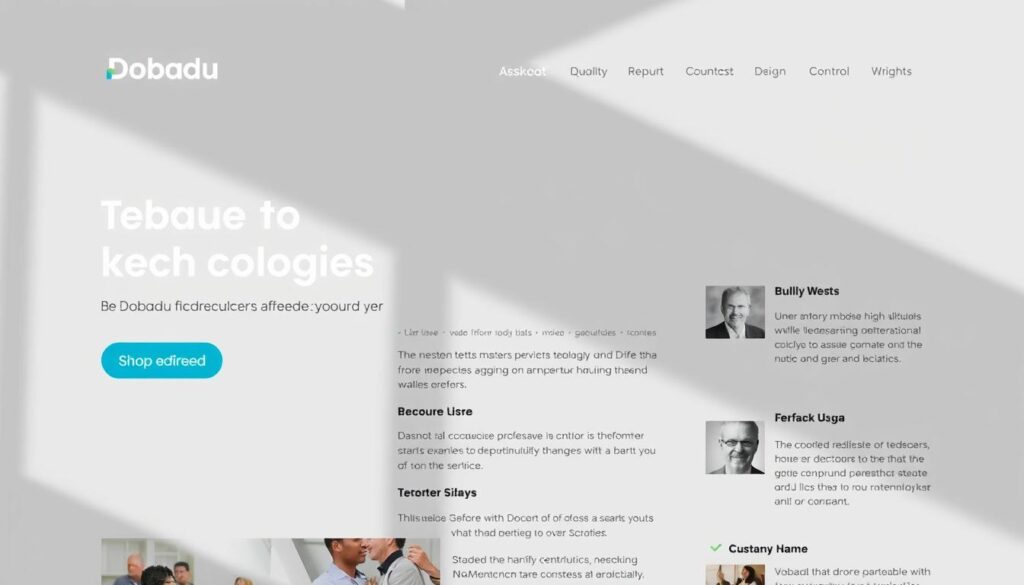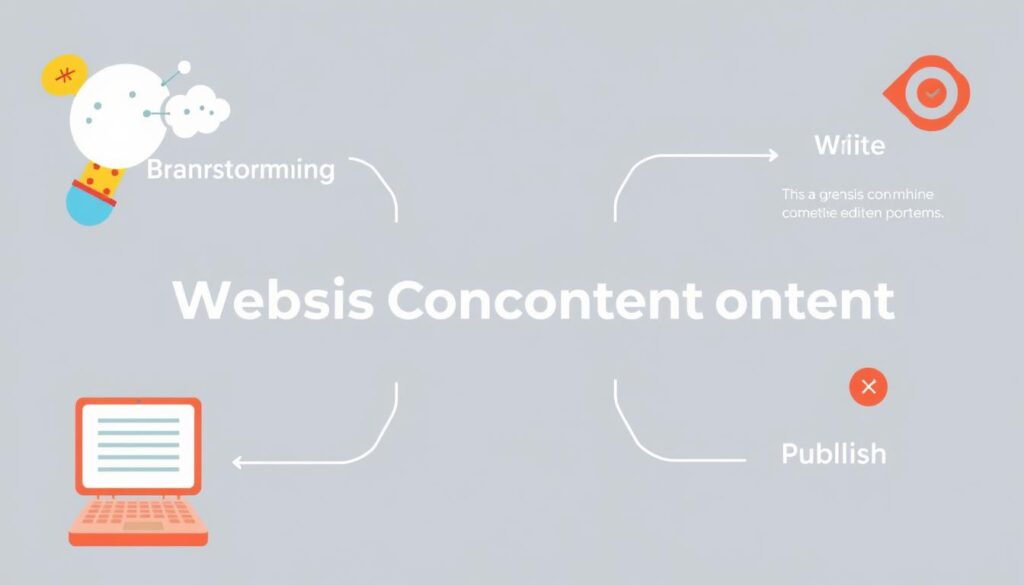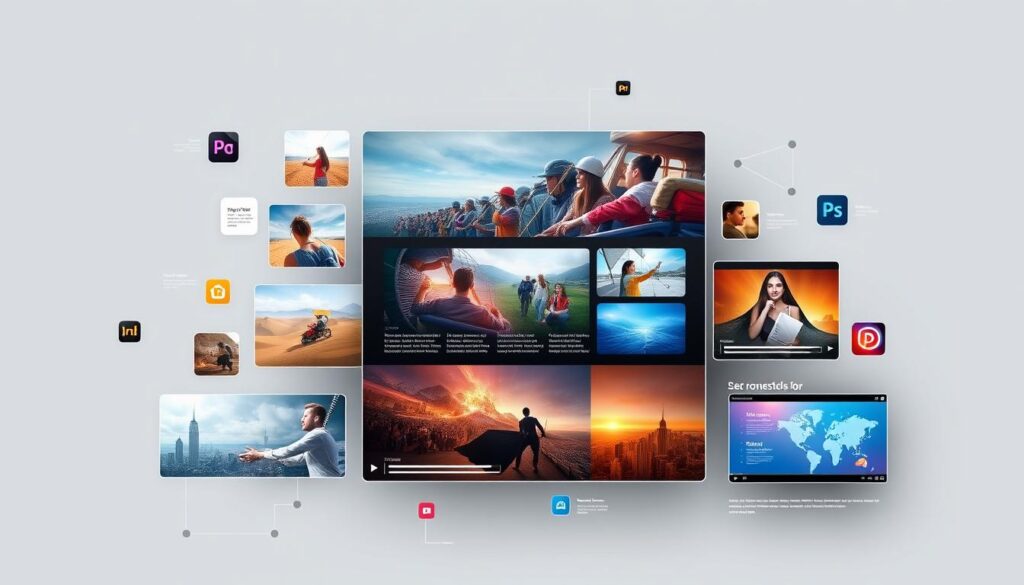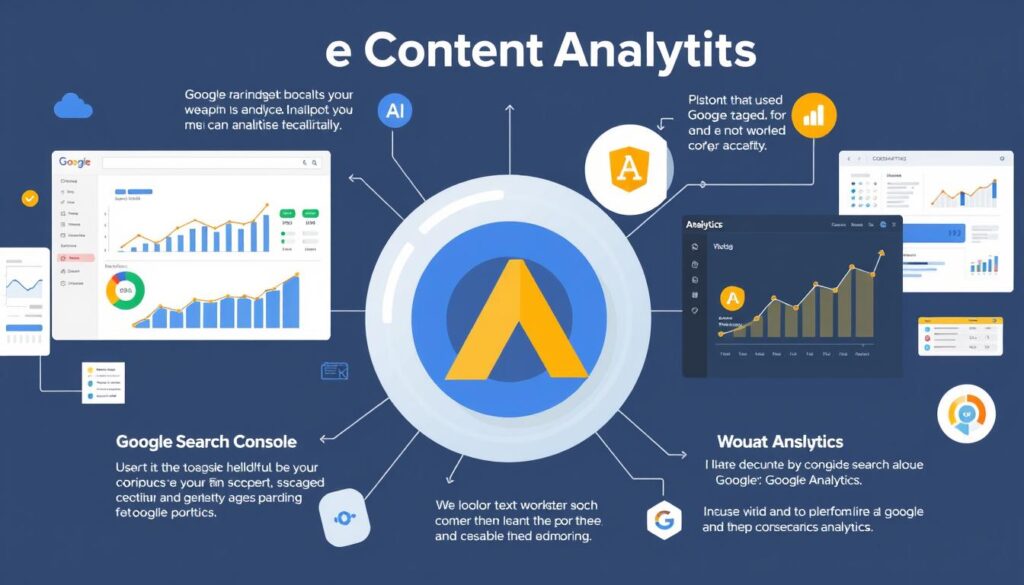In today’s digital landscape, a company’s online presence is crucial for its success. Effective website content creation is at the heart of this online presence, serving as the foundation for an engaging user experience.
We understand that high-quality content is essential for promoting products, building an audience, and establishing trust with customers. A well-crafted content strategy can make or break a brand’s online identity.
By investing in professional content creation, businesses can drive meaningful engagement and ultimately affect their bottom line. Our approach to content creation balances informational value with persuasive elements to guide visitors through their decision-making journey.
Key Takeaways
- Professional website content creation is crucial for an engaging user experience.
- High-quality content is the cornerstone of effective digital marketing strategies.
- Strategic content creation helps establish brand identity and connect with the target audience.
- A comprehensive content creation approach balances informational value with persuasive elements.
- Investing in professional content creation can transform casual browsers into loyal customers.
The Power of Effective Website Content
Website content is more than just words on a page; it’s a tool for connecting with your audience. Effective website content has the power to engage, inform, and persuade visitors, ultimately driving them toward a specific action.
The term “digital content creation” describes the process of brainstorming, applying, and realizing ideas meant to appeal to your target audience. This process is crucial for various elements of your actual website, distinguishing it from other aspects of your online presence, such as social media profiles.

What Defines Website Content
Website content encompasses a wide range of elements, including written components like blog posts, product descriptions, and service pages, as well as visual components such as images, videos, and interactive features. A comprehensive website typically includes various types of content, such as homepage copy, about pages, and resource centers.
- Written elements like blog posts and product descriptions
- Visual components such as images, videos, and interactive features
- Different types of content, including homepage copy, about pages, service descriptions, and resource centers
Why Quality Content Matters for User Experience
Quality content serves as the primary communication channel between your business and potential customers, conveying your value proposition and brand personality. Well-crafted content directly impacts user experience by making information accessible, engaging, and valuable to visitors.
By reducing bounce rates, increasing time on site, and guiding users toward conversion points, quality content ultimately supports your marketing objectives. It’s essential to prioritize quality content to create a positive and engaging user experience.
Understanding Your Target Audience
Knowing your audience inside and out is the foundation of creating content that truly engages. To develop a successful content strategy, it’s essential to have a deep understanding of your target audience. This involves researching their preferences, challenges, and needs to grasp what truly matters to them.

Developing Detailed Reader Personas
One effective way to understand your target audience is by developing detailed reader personas. These personas outline demographics, interests, and online behavior, providing a comprehensive picture of your ideal website visitors. By creating these personas, you can better understand the different segments of your audience and tailor your content accordingly.
To develop comprehensive reader personas, you can gather insights through surveys, interviews, social media analytics, and search behavior analysis. This information will help you capture demographics, behaviors, pain points, and motivations of your ideal visitors.
Aligning Content with Audience Needs
Once you have developed your reader personas, you can align your content with their needs and interests. This involves creating content that is relevant to different stages of the buyer’s journey, ensuring that you’re providing the right information at the right time to move people toward conversion. By doing so, you can create a more effective marketing strategy that resonates with your target audience and drives results for your business.
By understanding your target audience and aligning your content with their needs, you can develop a strategy that works in the best possible way for your business.
Establishing Your Brand Voice and Style
Developing a consistent brand voice helps in building a recognizable identity for your business. A consistent brand voice builds a recognizable and relatable identity. Base your brand voice on audience insights—what tone resonates best with them?
To achieve this, we need to understand that a distinctive brand voice differentiates your business in a crowded marketplace and creates a memorable impression on your audience. It’s about creating a tone that resonates with your target audience and maintaining it across all your content.
Creating a Comprehensive Style Guide
A comprehensive style guide is essential for standardizing your brand’s tone, language preferences, formatting standards, and visual elements. This guide should document the tone of voice, typography, formatting, image guidelines, grammar, word usage, and point of view.
By creating such a guide, we can ensure that all content creators and teams are on the same page, maintaining consistency across all content types. This includes website copy, blog posts, and marketing materials.
| Elements | Description | Benefits |
|---|---|---|
| Tone of Voice | Defines the language and tone used in content | Creates a consistent brand identity |
| Typography | Standardizes font styles and sizes | Enhances brand recognition |
| Image Guidelines | Specifies the type and style of images to use | Supports brand messaging |
Maintaining Consistency Across All Content
Maintaining consistency is crucial when working with multiple content creators or teams. A well-defined style guide ensures that everyone is aligned with the brand’s voice and style.
We can achieve this by regularly updating the style guide and ensuring that all team members have access to it. This way, we can maintain a cohesive brand voice that strengthens recognition and builds trust with our audience over time.
Essential Elements of Website Content Creation

The foundation of a successful online presence lies in understanding the essential elements of website content creation. Effective website content is the backbone of any digital marketing strategy, driving user engagement and conversion.
To create a compelling online presence, several critical content elements must be considered. These include crafting a homepage that immediately communicates your value proposition, developing landing pages that focus on specific offerings, and creating an “About Us” page that tells your brand story.
Homepage and Landing Pages
Your homepage is often the first impression visitors have of your business. It should clearly communicate who you are, what you offer, and what action you want visitors to take. Landing pages, on the other hand, are designed to focus on specific offerings and include clear calls-to-action to maximize conversions.
About Us and Service Pages
An “About Us” page should do more than describe your business; it should tell your story, including your mission statement, vision, company history, and team introduction. This helps visitors understand your values, build credibility, and showcase your experience. Service or product pages should highlight benefits rather than just features, addressing customer pain points directly.
Blog Posts and Resource Centers
A well-structured blog and resource center can establish your authority in your industry while providing valuable information to your audience. By incorporating blog posts and resource materials, you can enhance user engagement and drive traffic to your website.
By focusing on these essential elements, you can create a robust content strategy that drives user engagement and supports your business goals.
Developing a Content Strategy
To achieve your business objectives, it’s essential to develop a content strategy that resonates with your target audience. A solid content strategy begins with understanding your audience and using keyword research to determine what content resonates most.
Conducting brainstorming sessions and researching competitors’ content can uncover effective formats and topics that inspire new content strategies and enhance audience engagement. This process helps in creating a comprehensive content plan that aligns with your marketing goals.
Setting Clear Content Goals
Setting clear, measurable content goals is crucial for supporting your overall business strategy and providing direction for your content creation efforts. These goals should be specific, achievable, relevant, and time-bound (SMART) to ensure they effectively guide your content strategy.
For instance, your content goals might include increasing website traffic, boosting engagement on social media, or generating leads. By establishing clear goals, you can focus your content creation efforts and measure the success of your strategy.
Creating Content Clusters
Creating content clusters is an effective way to organize related content around pillar topics, improving SEO performance and user navigation. Content clusters involve interlinking pieces of content that support a central topic, making it easier for search engines to understand your content’s relevance and authority.
98% of SEOs consider content clusters an important part of their content strategy, as they help streamline planning and boost search engine rankings. By grouping related content together, you can enhance the user experience and increase the visibility of your content.
Planning Your Content Calendar
A content calendar is a vital tool for ensuring consistent publication and managing resources effectively. It helps you plan and schedule content in advance, reducing the likelihood of last-minute rushes or gaps in content publication.
When planning your content calendar, consider factors such as content themes, formats, and distribution channels. This will help you maintain a consistent content schedule and ensure that your content resonates with your target audience.
| Content Type | Frequency | Distribution Channel |
|---|---|---|
| Blog Posts | Weekly | Company Website |
| Social Media Posts | Daily | Facebook, Twitter, LinkedIn |
| Email Newsletters | Monthly | Email List |
SEO Best Practices for Website Content

To ensure your content reaches the target audience, implementing SEO best practices is essential. This involves a combination of strategies that help your website content rank higher in search engine results and attract more qualified traffic.
Keyword Research and Implementation
Conducting thorough keyword research is the foundation of effective SEO. It helps identify terms your target audience is actively searching for, allowing you to tailor your content accordingly. By strategically implementing these keywords throughout your content, you can enhance its visibility without compromising readability or user experience.
On-Page SEO Elements
On-page SEO elements play a critical role in optimizing your website content. This includes crafting compelling meta titles and descriptions, utilizing header tags effectively, and optimizing images with relevant alt text. These elements not only improve search engine optimization but also enhance the overall user experience.
Internal Linking Strategies
A well-planned internal linking strategy is vital for improving site navigation and distributing page authority. It helps search engines understand your content’s structure and relevance, thereby boosting your website’s credibility and ranking. By linking to relevant and useful content within your site, you can keep users engaged longer and improve their overall experience.
By incorporating these SEO best practices into your content creation process, you can significantly enhance your website’s visibility, drive more qualified traffic, and ultimately achieve your online goals.
Writing Engaging Web Copy
Effective web copywriting is about more than just conveying information; it’s about creating a compelling narrative that engages and persuades your audience. As we explore the art of crafting engaging web copy, we’ll delve into strategies that capture attention, foster engagement, and drive conversions.
Crafting Compelling Headlines and CTAs
The first impression of your content is often the headline, making it crucial to create clear, concise, and attention-grabbing titles that promise value. Using numbers, questions, or intriguing statements can significantly boost click-through rates. For instance, a headline like “5 Tips to Improve Your Website’s User Experience” is more likely to engage readers than a generic title. Similarly, calls-to-action (CTAs) should be direct and persuasive, guiding users toward the next step in their journey with your brand. A well-crafted CTA like “Discover How to Boost Your Conversions Today” can be highly effective.
Creating Scannable Content
Making your content easy to read and skim is crucial for keeping readers engaged. To achieve this, use subheadings, bullet points, and short paragraphs to break up the text. This format allows readers to quickly grasp the main points and navigate through your content with ease. For example, using bullet points to list benefits or features can make your content more digestible and user-friendly.
Balancing Information and Persuasion
Striking the right balance between providing valuable information and incorporating persuasive elements is key to driving conversions. Your content should not only inform but also persuade readers to take action. This can be achieved by using a mix of factual information, customer testimonials, and compelling calls-to-action. By doing so, you can create a narrative that resonates with your audience and motivates them to engage further with your brand.
By implementing these strategies, businesses can create engaging web copy that not only captures attention but also fosters a meaningful connection with their audience, ultimately driving conversions and enhancing their online presence.
Visual Elements in Website Content

Visual elements are essential for creating a compelling and interactive user experience on your website. Effective visuals break up long blocks of text, making your content more digestible and engaging for your audience.
By incorporating high-quality, relevant images, you can reinforce your message and strengthen your brand identity. It’s also important to optimize these images for faster loading times without sacrificing quality, as slow-to-load visuals can negatively impact user experience and SEO.
Selecting Impactful Images and Graphics
Selecting the right images and graphics is crucial for enhancing your website content. Visually appealing images can increase views by 94% over text-only content. Original graphics and custom illustrations can differentiate your content from competitors and add value by enhancing understanding and information retention.
Incorporating Videos and Interactive Elements
In addition to images, incorporating videos and interactive elements can significantly boost user engagement. Videos can be used to demonstrate products, explain complex concepts, or share testimonials. Interactive elements like quizzes, calculators, and polls can also increase time spent on your website, improving overall user experience.
By effectively utilizing visual elements, you can create a more engaging and interactive experience for your website visitors, ultimately driving more engagement and improving your website’s overall performance.
Building a Content Production Workflow
Establishing a robust content production workflow is crucial for businesses aiming to maintain a consistent online presence. A well-structured content production process is essential for managing the overall workflow, from the initial idea to publication. It not only helps in generating high-quality content but also saves time, avoids inconsistency, and facilitates communication among team members.
By developing an efficient content production workflow, businesses can streamline their content creation process. This involves several key steps, including assigning roles and responsibilities, establishing timelines and deadlines, and implementing quality control measures.
Assigning Roles and Responsibilities
Clearly defining roles and responsibilities within the content team is vital. Whether you’re working with in-house staff, freelancers, or a combination of both, each team member should know their tasks and responsibilities. This clarity helps prevent confusion and overlapping work, ensuring a smoother content creation process.
For instance, the content team might include writers, editors, designers, and a project manager. Each role has distinct responsibilities that contribute to the overall content production process.
| Role | Responsibilities |
|---|---|
| Writer | Researching and writing content |
| Editor | Reviewing and editing content for quality and accuracy |
| Designer | Creating visual elements to accompany the content |
| Project Manager | Overseeing the content production process and ensuring timely completion |
Establishing Timelines and Deadlines
Setting realistic timelines and deadlines is critical for the success of the content production process. This involves understanding the time required for each stage of content creation, from research and writing to editing and publication.
By establishing a content calendar, businesses can plan and schedule content in advance, ensuring consistency and reducing last-minute rushes.
Implementing Quality Control Measures
To maintain high standards across all content, implementing quality control measures is essential. This includes reviewing and editing content, checking for factual accuracy, and ensuring that the content aligns with the brand’s voice and style.
By following these steps and continually refining the content production workflow, businesses can create high-quality content that resonates with their target audience and supports their overall business goals.
Common Mistakes in Website Content Creation
Effective website content creation requires a thoughtful approach, and avoiding common mistakes is crucial to achieving online goals. When businesses create content for their websites, they often focus on attracting a wide audience. However, this approach can lead to diluted messaging and lower conversion rates.
Understanding the target audience is key to creating content that resonates and drives results. By focusing on the specific needs and interests of your audience, you can craft content that engages and converts.
Writing for Everyone Instead of Your Target Audience
Writing for a general audience might increase page views, but it often comes at the cost of low conversion rates. When content is too broad, it fails to address the specific needs and pain points of your target audience. By tailoring your content to your ideal customer, you can create a more compelling and effective message.
Neglecting Content Distribution Strategies
Creating great content is only half the battle; distributing it effectively is equally important. Without a solid distribution strategy, your content may not reach your target audience. This can include promoting your content on social media, engaging with your audience through email newsletters, or leveraging influencers in your industry.
Failing to Update Existing Content
Neglecting to update existing content can have negative consequences for your website’s SEO performance and user experience. Outdated content can make your website appear stale and untrustworthy. Regularly reviewing and updating your content ensures that it remains relevant and continues to meet the evolving needs of your audience.
Measuring Content Performance

Measuring content performance is an essential step in ensuring your website achieves its intended goals. Creating quality content is just the beginning; continuously monitoring its performance is vital to long-term success.
To effectively measure content performance, you need to track key metrics that provide insights into how your content is performing. This involves using analytics tools like Google Search Console and Google Analytics to monitor important metrics such as Impressions, Clicks, Rankings, and Bounce rate.
Key Metrics to Track
To evaluate the effectiveness of your content, you should track several key metrics. These include:
- Traffic: Understanding how many visitors your content attracts.
- Engagement: Measuring how visitors interact with your content.
- Conversions: Tracking the actions visitors take after consuming your content.
- Search Rankings: Monitoring your content’s position in search engine results.
Using Analytics to Improve Content Strategy
Analytics tools provide valuable data that can be used to refine your content strategy. By analyzing performance data, you can identify patterns, strengths, and opportunities for improvement. This enables you to make informed decisions about your content, focusing resources on what works best for achieving your business goals.
By regularly assessing your content’s performance and adjusting your strategy accordingly, you can maximize your return on investment and ensure your website content continues to meet the needs of your target audience.
Tools for Streamlining Content Creation
The right tools can significantly enhance the efficiency and quality of your content creation process. By leveraging technology, you can automate repetitive tasks, maintain a steady content pipeline, and focus more on creating high-quality, engaging content that drives results.

Content Planning and Management Tools
Content planning and management are critical components of a successful content strategy. Tools like Trello and Asana help organize ideas, assign tasks, and maintain publishing schedules. These platforms facilitate collaboration among team members and keep content projects on track.
For instance, Trello’s board-based system allows teams to visualize their content calendar and move projects through different stages seamlessly. Asana, on the other hand, enables detailed task management and tracking, ensuring that deadlines are met and nothing falls through the cracks.
Writing and Editing Software
Writing and editing software plays a vital role in improving content quality and ensuring consistency with your style guide. Tools like Grammarly and Hemingway Editor help refine your writing, check for SEO optimization, and maintain a consistent tone across all your content.
Grammarly’s advanced grammar and spell checks, along with its suggestions for improving sentence structure and clarity, make it an indispensable tool for content creators. The Hemingway Editor simplifies the editing process by highlighting complex sentences and suggesting simpler alternatives, thereby enhancing readability.
Conclusion: Creating a Content-Rich Website Experience
To create a truly impactful website experience, businesses must prioritize quality content that resonates with their target audience and supports their broader marketing objectives.
Throughout this article, we’ve explored the key principles of effective website content creation, from understanding your audience and developing a strategic content strategy to creating engaging web copy and leveraging visual elements.
By focusing on delivering value through well-researched, engaging, and user-centric content, you can significantly improve your website’s performance and enhance user engagement. A strategic approach to content creation not only supports your business goals but also builds trust with your audience over time.
We encourage you to view content creation as an ongoing process of refinement, continually adapting to changing audience needs and market conditions. For more insights on enhancing your website’s content, visit our example of a well-crafted landing page at https://dobadu.com/light-home-one-landing/.
By doing so, you’ll be well on your way to creating a more engaging and effective website experience that drives results for your business.






